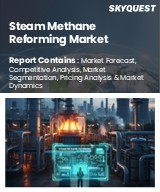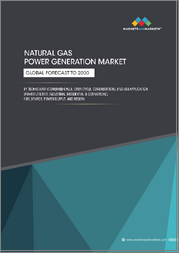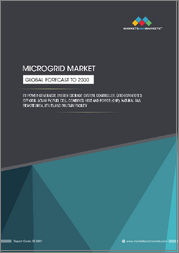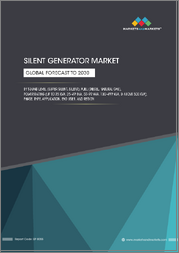
|
시장보고서
상품코드
1803909
에탄 시장 : 생산 방법 유형별, 용도 유형별, 최종 용도 유형별, 유통경로 유형별, 지역별 - 산업 동향과 세계 예측(-2035년)Ethane Market, Till 2035: Distribution by Type of Production Method, Type of Application, Type of End-Use, Type of Distribution Channel, and Geographical Regions: Industry Trends and Global Ethane Market Forecasts |
||||||
세계의 에탄 시장 규모는 현재 138억 7,000만 달러에서 2035년까지 214억 5,000만 달러에 달할 것으로 예측되며, 2035년까지의 예측 기간에 CAGR로 4.04%의 성장이 전망됩니다.
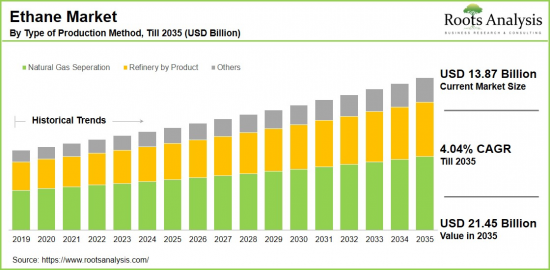
에탄 시장 : 성장과 동향
세계 에탄 시장이 성장한 이유는 여러 가지가 있습니다. 그 중 하나는 명확한 산업 요구 사항에 맞는 특수한 맞춤형 제품을 생산할 수 있는 능력입니다. 에탄은 플라스틱, 용제, 세제 등의 제품을 생산하기 위해 다양한 분야에서 활용되고 있으며, 산업화에서 중요한 역할을 하고 있습니다. 또한 에탄은 연소, 분해 등 특정 특성을 나타내어 산업에서의 유용성을 더욱 높이고 있습니다.
특히 에탄의 특성은 수증기 분해와 같은 다양한 처리 기술을 통해 조정할 수 있으며, 특정 용도에 맞게 수율과 성능을 향상시킬 수 있다는 점이 주목할 만합니다. 에탄은 에너지, 제조, 운송을 포함한 여러 산업에서 사용되고 있으며, 현대 산업화의 기초가 되고 있습니다. 또한 기술의 발전과 발전이 진행됨에 따라 지속가능한 에너지 솔루션과 혁신적인 화학 공정에 대한 기여로 인해 에탄 수요는 증가할 것으로 예측됩니다.
에탄 부문은 기술 혁신과 기술 발전에 힘입어 꾸준히 발전하고 있습니다. 이러한 변화는 에탄과 폴리우레탄을 보다 효율적이고 고성능의 재료로 개발하는 것을 촉진하고 있습니다. 또한 비산화 탈수소(EDH) 및 탈수소 방향족화(EDA)와 같은 최근 기술 혁신은 가치 있는 제품에 기존 열분해 방법보다 더 나은 선택성을 제공하는 유망 기술로 부상하고 있습니다.
또 다른 주목할 만한 발전은 바이오 에탄 시장 개발의 확대입니다. 이는 옥수수, 사탕수수 등의 원료로 공급되는 바이오 에탄올과 바이오 에탄올의 탈수 등 환경적 지속가능성에 대한 우려를 해소하기 위함입니다. 이러한 지속적인 노력으로 에탄 시장은 예측 기간 중 크게 성장할 것으로 예측됩니다.
세계의 에탄 시장에 대해 조사분석했으며, 시장 규모 추산과 기회의 분석, 경쟁 구도, 기업 개요 등의 정보를 제공하고 있습니다.
목차
제1장 서문
제2장 조사 방법
제3장 경제적 고려사항, 기타 프로젝트 특유의 고려 사항
제4장 거시경제 지표
제5장 개요
제6장 서론
제7장 경쟁 구도
제8장 에탄 시장에서의 스타트업 에코시스템
제9장 기업 개요
- 챕터 개요
- Abu Dhabi National Oil Company
- Air Liquide
- American Ethane
- BOREALIS
- Devon Energy
- Dow Chemical
- EQUATE Petrochemical
- ExxonMobil
- Formosa Petrochemical
- Indorama
- INEOS
- LyondellBasell
- Occidental
- ONEOK
- Qatar Petroleum
- Reliance Industries Limited
- Royal Dutch Shell
- SABIC
- Saudi Aramco
- The Williams Companies
제10장 밸류체인 분석
제11장 SWOT의 분석
제12장 세계의 에탄 시장
제13장 시장 기회 : 생산 방법 유형별
제14장 시장 기회 : 용도 유형별
제15장 시장 기회 : 최종 용도별
제16장 시장 기회 : 유통 채널 유형별
제17장 북미의 에탄의 시장 기회
제18장 유럽의 에탄의 시장 기회
제19장 아시아의 에탄의 시장 기회
제20장 중동·북아프리카(MENA)의 에탄의 시장 기회
제21장 라틴아메리카의 에탄의 시장 기회
제22장 기타 지역의 에탄의 시장 기회
제23장 표형식 데이터
제24장 기업·단체 리스트
제25장 커스터마이즈 기회
제26장 Roots 서브스크립션 서비스
제27장 저자 상세
KSA 25.09.11Ethane Market Overview
As per Roots Analysis, the global ethane market size is estimated to grow from USD 13.87 billion in the current year to USD 21.45 billion by 2035, at a CAGR of 4.04% during the forecast period, till 2035.

The opportunity for ethane market has been distributed across the following segments:
Type of Production Method
- Natural Gas Separation
- Refinery by-product
- Others
Type of Application
- Acetic Acid Synthesis
- Ethylene Synthesis
- Refrigerant
End-User
- Automotive and Transportation
- Construction
- Electrical & Electronics
- Packaging
- Others
Type of Distribution Channel
- Offline
- Online
Geographical Regions
- North America
- US
- Canada
- Mexico
- Other North American countries
- Europe
- Austria
- Belgium
- Denmark
- France
- Germany
- Ireland
- Italy
- Netherlands
- Norway
- Russia
- Spain
- Sweden
- Switzerland
- UK
- Other European countries
- Asia
- China
- India
- Japan
- Singapore
- South Korea
- Other Asian countries
- Latin America
- Brazil
- Chile
- Colombia
- Venezuela
- Other Latin American countries
- Middle East and North Africa
- Egypt
- Iran
- Iraq
- Israel
- Kuwait
- Saudi Arabia
- UAE
- Other MENA countries
- Rest of the World
- Australia
- New Zealand
- Other countries
Ethane Market: Growth and Trends
The global ethane market has emerged for several reasons, one of which is its capability to produce specialized and customized products tailored for distinct industry requirements. Ethane plays a vital role in industrialization, as it is utilized in various sectors to create products such as plastics, solvents, and detergents. Moreover, ethane exhibits certain characteristics like combustion and cracking, which further increase its usefulness in industry.
It is important to mention that the properties of ethane can be adjusted through various processing techniques, such as steam cracking, to enhance yield and performance for specific uses. Significantly, ethane is employed across multiple industries, including energy, manufacturing, and transportation, making it a foundational element of contemporary industrialization. Additionally, with ongoing technological progress and development, the demand for ethane is projected to rise, propelled by its contribution to sustainable energy solutions and innovative chemical processes.
The ethane sector is consistently evolving, fueled by innovation and advancements in technology. This transformation has facilitated the development of ethane and polyurethane as more efficient and high-performance materials. Furthermore, recent innovations such as non-oxidative dehydrogenation (EDH) and dehydroaromatization (EDA) are emerging as promising techniques that offer superior selectivity for valuable products when compared to traditional thermal cracking methods.
Another notable advancement is the growing development of the bio-based ethane market, which addresses concerns about environmental sustainability, such as the dehydration of bio-based ethanol or bio-ethanol sourced from feedstocks like corn and sugarcane. Due to these ongoing initiatives, the ethane market is expected to experience significant growth during the forecast period.
Ethane Market: Key Segments
Market Share by Type of Production Method
Based on type of production method, the global ethane market is segmented into natural gas separation, refinery by-products, and others. According to our estimates, currently, the natural gas separation segment captures the majority share of the market.
This growth can be attributed to its strong dependence on extracting ethane from natural gas. The rising demand for ethylene and its derivatives, which are sourced from ethane, fuels the need for ethane obtained through natural gas separation.
However, the market for refinery by-products is expected to grow at a higher CAGR during the forecast period, due to the growing need for sustainable and renewable materials, like bioplastics, that can be manufactured from ethane produced as a by-product of refining processes.
Market Share by Type of Application
Based on type of application, the ethane market is segmented into acetic acid production, ethylene production, and refrigerants. According to our estimates, currently, the ethylene production segment captures the majority of the market. This growth can be attributed to the increasing demand for ethylene, which is fueled by its uses in industries like food safety and agriculture, as well as cost-effective manufacturing and the efficiency of ethylene production.
Market Share by End-User
Based on end-user, the ethane market is segmented into automotive and transportation, construction, electrical & electronics, packaging and others. According to our estimates, currently, the automotive and transportation segment captures the majority share of the market. This is due to its strong demand for ethane, especially because it serves as a cleaner alternative fuel and is crucial in the production of ethylene, which plays a vital role in numerous automotive uses.
However, the market for packaging segment is expected to grow at a higher CAGR during the forecast period. Key factors driving this growth include the increasing need for ethylene, which is vital for manufacturing a range of plastics utilized in food safety and storage solutions.
Market Share by Type of Distribution Channel
Based on type of distribution channel, the ethane market is segmented into offline and online. According to our estimates, currently, the offline segment captures the majority share of the market, due to its capacity to create personal connections with customers, thereby fostering loyalty.
However, the online sector is expected to grow at a higher CAGR during the forecast period. This can be attributed to the increasing use of smart devices and widespread internet connectivity, which improve product visibility and accessibility, enabling consumers to conveniently purchase ethane and its derivatives online.
Market Share by Geographical Regions
Based on geographical regions, the ethane market is segmented into North America, Europe, Asia, Latin America, Middle East and North Africa, and the rest of the world. According to our estimates, currently, Asia-Pacific captures the majority share of the market. This can be attributed to the rising demand for ethane in various industries such as automotive, furniture, and electronics, especially in emerging economies like China and India.
However, North America is expected to witness a relatively higher CAGR during the forecast period, driven by increasing consumer awareness and a transition toward sustainable materials.
Example Players in Ethane Market
- Abu Dhabi National Oil Company
- Air Liquide
- American Ethane
- BOREALIS
- Devon Energy
- Dow Chemical
- EQUATE Petrochemical
- ExxonMobil
- Formosa Petrochemical
- Indorama
- INEOS
- LyondellBasell
- Occidental
- ONEOK
- Qatar Petroleum
- Reliance Industries Limited
- Royal Dutch Shell
- SABIC
- Saudi Aramco
- The Williams Companies
Ethane Market: Research Coverage
The report on the ethane market features insights on various sections, including:
- Market Sizing and Opportunity Analysis: An in-depth analysis of the ethane market, focusing on key market segments, including [A] type of production method, [B] type of application, [C] type of end-use, [D] type of distribution channel, and [E] geographical regions.
- Competitive Landscape: A comprehensive analysis of the companies engaged in the ethane market, based on several relevant parameters, such as [A] year of establishment, [B] company size, [C] location of headquarters and [D] ownership structure.
- Company Profiles: Elaborate profiles of prominent players engaged in the ethane market, providing details on [A] location of headquarters, [B] company size, [C] company mission, [D] company footprint, [E] management team, [F] contact details, [G] financial information, [H] operating business segments, [I] ethane portfolio, [J] moat analysis, [K] recent developments, and an informed future outlook.
- SWOT Analysis: An insightful SWOT framework, highlighting the strengths, weaknesses, opportunities and threats in the domain. Additionally, it provides Harvey ball analysis, highlighting the relative impact of each SWOT parameter.
- Value Chain Analysis: A comprehensive analysis of the value chain, providing information on the different phases and stakeholders involved in the ethane market
Key Questions Answered in this Report
- How many companies are currently engaged in ethane market?
- Which are the leading companies in this market?
- What factors are likely to influence the evolution of this market?
- What is the current and future market size?
- What is the CAGR of this market?
- How is the current and future market opportunity likely to be distributed across key market segments?
Reasons to Buy this Report
- The report provides a comprehensive market analysis, offering detailed revenue projections of the overall market and its specific sub-segments. This information is valuable to both established market leaders and emerging entrants.
- Stakeholders can leverage the report to gain a deeper understanding of the competitive dynamics within the market. By analyzing the competitive landscape, businesses can make informed decisions to optimize their market positioning and develop effective go-to-market strategies.
- The report offers stakeholders a comprehensive overview of the market, including key drivers, barriers, opportunities, and challenges. This information empowers stakeholders to stay abreast of market trends and make data-driven decisions to capitalize on growth prospects.
Additional Benefits
- Complimentary Excel Data Packs for all Analytical Modules in the Report
- 15% Free Content Customization
- Detailed Report Walkthrough Session with Research Team
- Free Updated report if the report is 6-12 months old or older
TABLE OF CONTENTS
1. PREFACE
- 1.1. Introduction
- 1.2. Market Share Insights
- 1.3. Key Market Insights
- 1.4. Report Coverage
- 1.5. Key Questions Answered
- 1.6. Chapter Outlines
2. RESEARCH METHODOLOGY
- 2.1. Chapter Overview
- 2.2. Research Assumptions
- 2.3. Database Building
- 2.3.1. Data Collection
- 2.3.2. Data Validation
- 2.3.3. Data Analysis
- 2.4. Project Methodology
- 2.4.1. Secondary Research
- 2.4.1.1. Annual Reports
- 2.4.1.2. Academic Research Papers
- 2.4.1.3. Company Websites
- 2.4.1.4. Investor Presentations
- 2.4.1.5. Regulatory Filings
- 2.4.1.6. White Papers
- 2.4.1.7. Industry Publications
- 2.4.1.8. Conferences and Seminars
- 2.4.1.9. Government Portals
- 2.4.1.10. Media and Press Releases
- 2.4.1.11. Newsletters
- 2.4.1.12. Industry Databases
- 2.4.1.13. Roots Proprietary Databases
- 2.4.1.14. Paid Databases and Sources
- 2.4.1.15. Social Media Portals
- 2.4.1.16. Other Secondary Sources
- 2.4.2. Primary Research
- 2.4.2.1. Introduction
- 2.4.2.2. Types
- 2.4.2.2.1. Qualitative
- 2.4.2.2.2. Quantitative
- 2.4.2.3. Advantages
- 2.4.2.4. Techniques
- 2.4.2.4.1. Interviews
- 2.4.2.4.2. Surveys
- 2.4.2.4.3. Focus Groups
- 2.4.2.4.4. Observational Research
- 2.4.2.4.5. Social Media Interactions
- 2.4.2.5. Stakeholders
- 2.4.2.5.1. Company Executives (CXOs)
- 2.4.2.5.2. Board of Directors
- 2.4.2.5.3. Company Presidents and Vice Presidents
- 2.4.2.5.4. Key Opinion Leaders
- 2.4.2.5.5. Research and Development Heads
- 2.4.2.5.6. Technical Experts
- 2.4.2.5.7. Subject Matter Experts
- 2.4.2.5.8. Scientists
- 2.4.2.5.9. Doctors and Other Healthcare Providers
- 2.4.2.6. Ethics and Integrity
- 2.4.2.6.1. Research Ethics
- 2.4.2.6.2. Data Integrity
- 2.4.3. Analytical Tools and Databases
- 2.4.1. Secondary Research
3. ECONOMIC AND OTHER PROJECT SPECIFIC CONSIDERATIONS
- 3.1. Forecast Methodology
- 3.1.1. Top-Down Approach
- 3.1.2. Bottom-Up Approach
- 3.1.3. Hybrid Approach
- 3.2. Market Assessment Framework
- 3.2.1. Total Addressable Market (TAM)
- 3.2.2. Serviceable Addressable Market (SAM)
- 3.2.3. Serviceable Obtainable Market (SOM)
- 3.2.4. Currently Acquired Market (CAM)
- 3.3. Forecasting Tools and Techniques
- 3.3.1. Qualitative Forecasting
- 3.3.2. Correlation
- 3.3.3. Regression
- 3.3.4. Time Series Analysis
- 3.3.5. Extrapolation
- 3.3.6. Convergence
- 3.3.7. Forecast Error Analysis
- 3.3.8. Data Visualization
- 3.3.9. Scenario Planning
- 3.3.10. Sensitivity Analysis
- 3.4. Key Considerations
- 3.4.1. Demographics
- 3.4.2. Market Access
- 3.4.3. Reimbursement Scenarios
- 3.4.4. Industry Consolidation
- 3.5. Robust Quality Control
- 3.6. Key Market Segmentations
- 3.7. Limitations
4. MACRO-ECONOMIC INDICATORS
- 4.1. Chapter Overview
- 4.2. Market Dynamics
- 4.2.1. Time Period
- 4.2.1.1. Historical Trends
- 4.2.1.2. Current and Forecasted Estimates
- 4.2.2. Currency Coverage
- 4.2.2.1. Overview of Major Currencies Affecting the Market
- 4.2.2.2. Impact of Currency Fluctuations on the Industry
- 4.2.3. Foreign Exchange Impact
- 4.2.3.1. Evaluation of Foreign Exchange Rates and Their Impact on Market
- 4.2.3.2. Strategies for Mitigating Foreign Exchange Risk
- 4.2.4. Recession
- 4.2.4.1. Historical Analysis of Past Recessions and Lessons Learnt
- 4.2.4.2. Assessment of Current Economic Conditions and Potential Impact on the Market
- 4.2.5. Inflation
- 4.2.5.1. Measurement and Analysis of Inflationary Pressures in the Economy
- 4.2.5.2. Potential Impact of Inflation on the Market Evolution
- 4.2.6. Interest Rates
- 4.2.6.1. Overview of Interest Rates and Their Impact on the Market
- 4.2.6.2. Strategies for Managing Interest Rate Risk
- 4.2.7. Commodity Flow Analysis
- 4.2.7.1. Type of Commodity
- 4.2.7.2. Origins and Destinations
- 4.2.7.3. Values and Weights
- 4.2.7.4. Modes of Transportation
- 4.2.8. Global Trade Dynamics
- 4.2.8.1. Import Scenario
- 4.2.8.2. Export Scenario
- 4.2.9. War Impact Analysis
- 4.2.9.1. Russian-Ukraine War
- 4.2.9.2. Israel-Hamas War
- 4.2.10. COVID Impact / Related Factors
- 4.2.10.1. Global Economic Impact
- 4.2.10.2. Industry-specific Impact
- 4.2.10.3. Government Response and Stimulus Measures
- 4.2.10.4. Future Outlook and Adaptation Strategies
- 4.2.11. Other Indicators
- 4.2.11.1. Fiscal Policy
- 4.2.11.2. Consumer Spending
- 4.2.11.3. Gross Domestic Product (GDP)
- 4.2.11.4. Employment
- 4.2.11.5. Taxes
- 4.2.11.6. R&D Innovation
- 4.2.11.7. Stock Market Performance
- 4.2.11.8. Supply Chain
- 4.2.11.9. Cross-Border Dynamics
- 4.2.1. Time Period
5. EXECUTIVE SUMMARY
6. INTRODUCTION
- 6.1. Chapter Overview
- 6.2. Overview of Ethane Market
- 6.2.1. Type of Production Method
- 6.2.2. Type of Application
- 6.2.3. Type of End-User
- 6.2.4. Type of Distribution Channel
- 6.3. Future Perspective
7. COMPETITIVE LANDSCAPE
- 7.1. Chapter Overview
- 7.2. Ethane: Overall Market Landscape
- 7.2.1. Analysis by Year of Establishment
- 7.2.2. Analysis by Company Size
- 7.2.3. Analysis by Location of Headquarters
- 7.2.4. Analysis by Ownership Structure
8. STARTUP ECOSYSTEM IN THE ETHANE MARKET
- 8.1. Ethane Market: Market Landscape of Startups
- 8.1.1. Analysis by Year of Establishment
- 8.1.2. Analysis by Company Size
- 8.1.3. Analysis by Company Size and Year of Establishment
- 8.1.4. Analysis by Location of Headquarters
- 8.1.5. Analysis by Company Size and Location of Headquarters
- 8.1.6. Analysis by Ownership Structure
- 8.2. Key Findings
9. COMPANY PROFILES
- 9.1. Chapter Overview
- 9.2. Abu Dhabi National Oil Company*
- 9.2.1. Company Overview
- 9.2.2. Company Mission
- 9.2.3. Company Footprint
- 9.2.4. Management Team
- 9.2.5. Contact Details
- 9.2.6. Financial Performance
- 9.2.7. Operating Business Segments
- 9.2.8. Service / Product Portfolio (project specific)
- 9.2.9. MOAT Analysis
- 9.2.10. Recent Developments and Future Outlook
- 9.3. Air Liquide
- 9.4. American Ethane
- 9.5. BOREALIS
- 9.6. Devon Energy
- 9.7. Dow Chemical
- 9.8. EQUATE Petrochemical
- 9.9. ExxonMobil
- 9.10. Formosa Petrochemical
- 9.11. Indorama
- 9.12. INEOS
- 9.13. LyondellBasell
- 9.14. Occidental
- 9.15. ONEOK
- 9.16. Qatar Petroleum
- 9.17. Reliance Industries Limited
- 9.18. Royal Dutch Shell
- 9.19. SABIC
- 9.20. Saudi Aramco
- 9.21. The Williams Companies
10. VALUE CHAIN ANALYSIS
11. SWOT ANALYSIS
12. GLOBAL ETHANE MARKET
- 12.1. Chapter Overview
- 12.2. Key Assumptions and Methodology
- 12.3. Trends Disruption Impacting Market
- 12.4. Global Ethane Market, Historical Trends (Since 2019) and Forecasted Estimates (Till 2035)
- 12.5. Multivariate Scenario Analysis
- 12.5.1. Conservative Scenario
- 12.5.2. Optimistic Scenario
- 12.6. Key Market Segmentations
13. MARKET OPPORTUNITIES BASED ON TYPE OF PRODUCTION METHOD
- 13.1. Chapter Overview
- 13.2. Key Assumptions and Methodology
- 13.3. Revenue Shift Analysis
- 13.4. Market Movement Analysis
- 13.5. Penetration-Growth (P-G) Matrix
- 13.6. Ethane Market for Natural Gas: Historical Trends (Since 2019) and Forecasted Estimates (Till 2035)
- 13.7. Ethane Market for Refinery by-Product: Historical Trends (Since 2019) and Forecasted Estimates (Till 2035)
- 13.8. Ethane Market for Others: Historical Trends (Since 2019) and Forecasted Estimates (Till 2035)
- 13.9. Data Triangulation and Validation
14. MARKET OPPORTUNITIES BASED ON TYPE OF APPLICATION
- 14.1. Chapter Overview
- 14.2. Key Assumptions and Methodology
- 14.3. Revenue Shift Analysis
- 14.4. Market Movement Analysis
- 14.5. Penetration-Growth (P-G) Matrix
- 14.6. Ethane Market for Acetic Acid Synthesis: Historical Trends (Since 2019) and Forecasted Estimates (Till 2035)
- 14.7. Ethane Market for Ethylene Synthesis: Historical Trends (Since 2019) and Forecasted Estimates (Till 2035)
- 14.8. Ethane Market for Refrigerant: Historical Trends (Since 2019) and Forecasted Estimates (Till 2035)
- 14.9. Data Triangulation and Validation
15. MARKET OPPORTUNITIES BASED ON END-USER
- 15.1. Chapter Overview
- 15.2. Key Assumptions and Methodology
- 15.3. Revenue Shift Analysis
- 15.4. Market Movement Analysis
- 15.5. Penetration-Growth (P-G) Matrix
- 15.6. Ethane Market for Automotive and Transportation: Historical Trends (Since 2019) and Forecasted Estimates (Till 2035)
- 15.7. Ethane Market for Construction: Historical Trends (Since 2019) and Forecasted Estimates (Till 2035)
- 15.8. Ethane Market for Electrical & Electronics: Historical Trends (Since 2019) and Forecasted Estimates (Till 2035)
- 15.9. Ethane Market for Packaging: Historical Trends (Since 2019) and Forecasted Estimates (Till 2035)
- 15.10. Ethane Market for Others: Historical Trends (Since 2019) and Forecasted Estimates (Till 2035)
- 15.11. Data Triangulation and Validation
16. MARKET OPPORTUNITIES BASED ON TYPE OF DISTRIBUTION CHANNEL
- 16.1. Chapter Overview
- 16.2. Key Assumptions and Methodology
- 16.3. Revenue Shift Analysis
- 16.4. Market Movement Analysis
- 16.5. Penetration-Growth (P-G) Matrix
- 16.6. Ethane Market for Offline: Historical Trends (Since 2019) and Forecasted Estimates (Till 2035)
- 16.7. Ethane Market for Online: Historical Trends (Since 2019) and Forecasted Estimates (Till 2035)
- 16.8. Data Triangulation and Validation
17. MARKET OPPORTUNITIES FOR ETHANE IN NORTH AMERICA
- 17.1. Chapter Overview
- 17.2. Key Assumptions and Methodology
- 17.3. Revenue Shift Analysis
- 17.4. Market Movement Analysis
- 17.5. Penetration-Growth (P-G) Matrix
- 17.6. Ethane Market in North America: Historical Trends (Since 2019) and Forecasted Estimates (Till 2035)
- 17.6.1. Ethane Market in the US: Historical Trends (Since 2019) and Forecasted Estimates (Till 2035)
- 17.6.2. Ethane Market in Canada: Historical Trends (Since 2019) and Forecasted Estimates (Till 2035)
- 17.6.3. Ethane Market in Mexico: Historical Trends (Since 2019) and Forecasted Estimates (Till 2035)
- 17.6.4. Ethane Market in Other North American Countries: Historical Trends (Since 2019) and Forecasted Estimates (Till 2035)
- 17.7. Data Triangulation and Validation
18. MARKET OPPORTUNITIES FOR ETHANE IN EUROPE
- 18.1. Chapter Overview
- 18.2. Key Assumptions and Methodology
- 18.3. Revenue Shift Analysis
- 18.4. Market Movement Analysis
- 18.5. Penetration-Growth (P-G) Matrix
- 18.6. Ethane Market in Europe: Historical Trends (Since 2019) and Forecasted Estimates (Till 2035)
- 18.6.1. Ethane Market in Austria: Historical Trends (Since 2019) and Forecasted Estimates (Till 2035)
- 18.6.2. Ethane Market in Belgium: Historical Trends (Since 2019) and Forecasted Estimates (Till 2035)
- 18.6.3. Ethane Market in Denmark: Historical Trends (Since 2019) and Forecasted Estimates (Till 2035)
- 18.6.4. Ethane Market in France: Historical Trends (Since 2019) and Forecasted Estimates (Till 2035)
- 18.6.5. Ethane Market in Germany: Historical Trends (Since 2019) and Forecasted Estimates (Till 2035)
- 18.6.6. Ethane Market in Ireland: Historical Trends (Since 2019) and Forecasted Estimates (Till 2035)
- 18.6.7. Ethane Market in Italy: Historical Trends (Since 2019) and Forecasted Estimates (Till 2035)
- 18.6.8. Ethane Market in Netherlands: Historical Trends (Since 2019) and Forecasted Estimates (Till 2035)
- 18.6.9. Ethane Market in Norway: Historical Trends (Since 2019) and Forecasted Estimates (Till 2035)
- 18.6.10. Ethane Market in Russia: Historical Trends (Since 2019) and Forecasted Estimates (Till 2035)
- 18.6.11. Ethane Market in Spain: Historical Trends (Since 2019) and Forecasted Estimates (Till 2035)
- 18.6.12. Ethane Market in Sweden: Historical Trends (Since 2019) and Forecasted Estimates (Till 2035)
- 18.6.13. Ethane Market in Sweden: Historical Trends (Since 2019) and Forecasted Estimates (Till 2035)
- 18.6.14. Ethane Market in Switzerland: Historical Trends (Since 2019) and Forecasted Estimates (Till 2035)
- 18.6.15. Ethane Market in the UK: Historical Trends (Since 2019) and Forecasted Estimates (Till 2035)
- 18.6.16. Ethane Market in Other European Countries: Historical Trends (Since 2019) and Forecasted Estimates (Till 2035)
- 18.7. Data Triangulation and Validation
19. MARKET OPPORTUNITIES FOR ETHANE IN ASIA
- 19.1. Chapter Overview
- 19.2. Key Assumptions and Methodology
- 19.3. Revenue Shift Analysis
- 19.4. Market Movement Analysis
- 19.5. Penetration-Growth (P-G) Matrix
- 19.6. Ethane Market in Asia: Historical Trends (Since 2019) and Forecasted Estimates (Till 2035)
- 19.6.1. Ethane Market in China: Historical Trends (Since 2019) and Forecasted Estimates (Till 2035)
- 19.6.2. Ethane Market in India: Historical Trends (Since 2019) and Forecasted Estimates (Till 2035)
- 19.6.3. Ethane Market in Japan: Historical Trends (Since 2019) and Forecasted Estimates (Till 2035)
- 19.6.4. Ethane Market in Singapore: Historical Trends (Since 2019) and Forecasted Estimates (Till 2035)
- 19.6.5. Ethane Market in South Korea: Historical Trends (Since 2019) and Forecasted Estimates (Till 2035)
- 19.6.6. Ethane Market in Other Asian Countries: Historical Trends (Since 2019) and Forecasted Estimates (Till 2035)
- 19.7. Data Triangulation and Validation
20. MARKET OPPORTUNITIES FOR ETHANE IN MIDDLE EAST AND NORTH AFRICA (MENA)
- 20.1. Chapter Overview
- 20.2. Key Assumptions and Methodology
- 20.3. Revenue Shift Analysis
- 20.4. Market Movement Analysis
- 20.5. Penetration-Growth (P-G) Matrix
- 20.6. Ethane Market in Middle East and North Africa (MENA): Historical Trends (Since 2019) and Forecasted Estimates (Till 2035)
- 20.6.1. Ethane Market in Egypt: Historical Trends (Since 2019) and Forecasted Estimates (Till 205)
- 20.6.2. Ethane Market in Iran: Historical Trends (Since 2019) and Forecasted Estimates (Till 2035)
- 20.6.3. Ethane Market in Iraq: Historical Trends (Since 2019) and Forecasted Estimates (Till 2035)
- 20.6.4. Ethane Market in Israel: Historical Trends (Since 2019) and Forecasted Estimates (Till 2035)
- 20.6.5. Ethane Market in Kuwait: Historical Trends (Since 2019) and Forecasted Estimates (Till 2035)
- 20.6.6. Ethane Market in Saudi Arabia: Historical Trends (Since 2019) and Forecasted Estimates (Till 2035)
- 20.6.7. Ethane Market in United Arab Emirates (UAE): Historical Trends (Since 2019) and Forecasted Estimates (Till 2035)
- 20.6.8. Ethane Market in Other MENA Countries: Historical Trends (Since 2019) and Forecasted Estimates (Till 2035)
- 20.7. Data Triangulation and Validation
21. MARKET OPPORTUNITIES FOR ETHANE IN LATIN AMERICA
- 21.1. Chapter Overview
- 21.2. Key Assumptions and Methodology
- 21.3. Revenue Shift Analysis
- 21.4. Market Movement Analysis
- 21.5. Penetration-Growth (P-G) Matrix
- 21.6. Ethane Market in Latin America: Historical Trends (Since 2019) and Forecasted Estimates (Till 2035)
- 21.6.1. Ethane Market in Argentina: Historical Trends (Since 2019) and Forecasted Estimates (Till 2035)
- 21.6.2. Ethane Market in Brazil: Historical Trends (Since 2019) and Forecasted Estimates (Till 2035)
- 21.6.3. Ethane Market in Chile: Historical Trends (Since 2019) and Forecasted Estimates (Till 2035)
- 21.6.4. Ethane Market in Colombia Historical Trends (Since 2019) and Forecasted Estimates (Till 2035)
- 21.6.5. Ethane Market in Venezuela: Historical Trends (Since 2019) and Forecasted Estimates (Till 2035)
- 21.6.6. Ethane Market in Other Latin American Countries: Historical Trends (Since 2019) and Forecasted Estimates (Till 2035)
- 21.7. Data Triangulation and Validation
22. MARKET OPPORTUNITIES FOR ETHANE IN REST OF THE WORLD
- 22.1. Chapter Overview
- 22.2. Key Assumptions and Methodology
- 22.3. Revenue Shift Analysis
- 22.4. Market Movement Analysis
- 22.5. Penetration-Growth (P-G) Matrix
- 22.6. Ethane Market in Rest of the World: Historical Trends (Since 2019) and Forecasted Estimates (Till 2035)
- 22.6.1. Ethane Market in Australia: Historical Trends (Since 2019) and Forecasted Estimates (Till 2035)
- 22.6.2. Ethane Market in New Zealand: Historical Trends (Since 2019) and Forecasted Estimates (Till 2035)
- 22.6.3. Ethane Market in Other Countries
- 22.7. Data Triangulation and Validation







